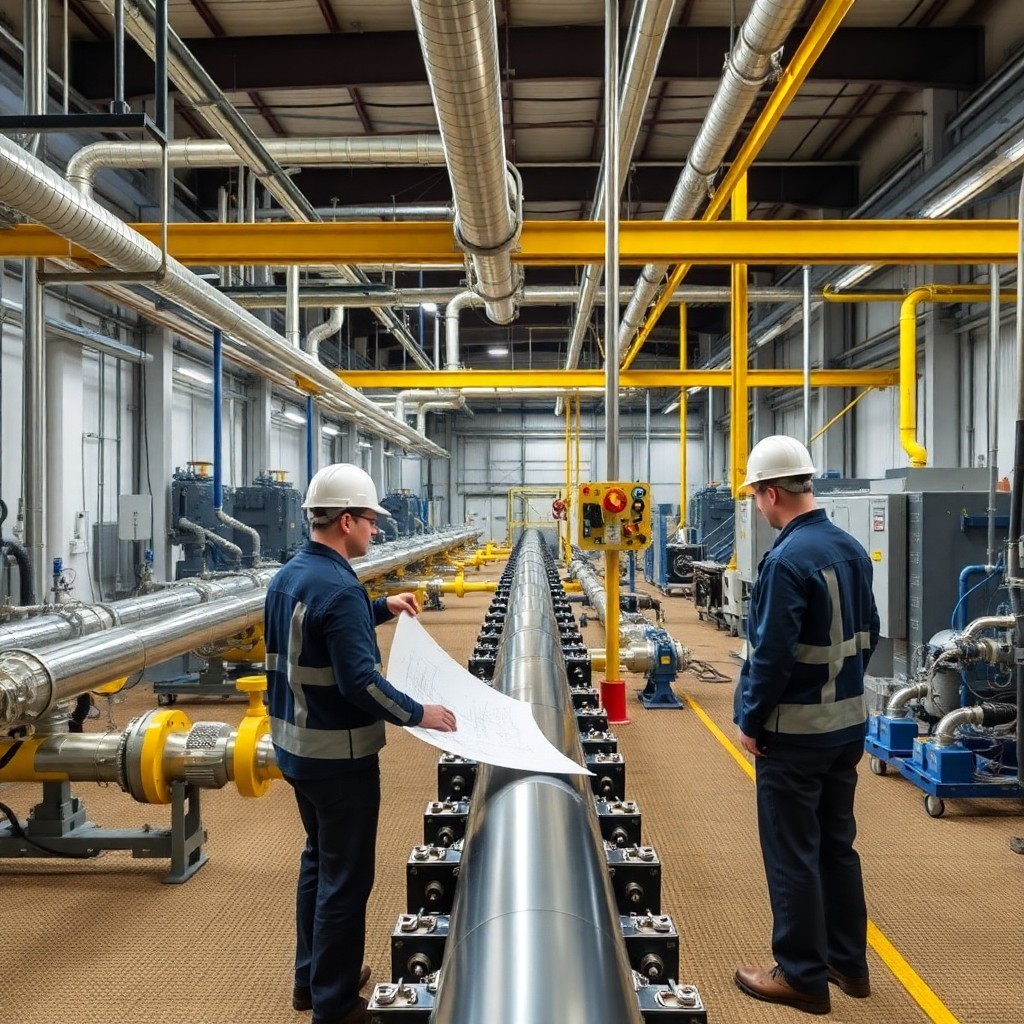
Why Tubing is Essential in the Oil and Gas Industry
Share
Introduction
Tubing plays a crucial role in the oil and gas industry, serving as a conduit for the extraction and transportation of hydrocarbons from wellbores to the surface. It is an essential component of the production process, providing a means for the safe and efficient transfer of oil, natural gas, and other fluids from deep within the earth to processing facilities.
Tubing systems are designed to withstand high-pressure and high-temperature environments, making them indispensable in the extraction and production of hydrocarbons.Tubing in the oil and gas industry is subject to stringent regulations and standards to ensure the safety and integrity of operations.
The design, installation, and maintenance of tubing systems are critical aspects of well construction and production operations. As such, the selection of appropriate tubing materials, dimensions, and configurations is vital to the overall success and efficiency of oil and gas extraction processes.
Key Takeaways
- Tubing is essential in the oil and gas industry for extracting, transporting, and maintaining wellbore integrity.
- Tubing plays a crucial role in oil and gas extraction by providing a conduit for the flow of hydrocarbons from the reservoir to the surface.
- Wellbore integrity and production are heavily reliant on the proper selection and installation of tubing to ensure efficient and safe operations.
- Various types of tubing, such as seamless, welded, and coiled tubing, are used in the oil and gas industry to meet specific operational requirements.
- Challenges in tubing design and installation, as well as the importance of regular maintenance and inspection, are critical for ensuring the reliability and safety of tubing systems in the oil and gas industry.
The Role of Tubing in Oil and Gas Extraction
Role in Oil Wells
In oil wells, tubing is run inside the casing to provide a pathway for hydrocarbons to flow to the surface. It also facilitates the injection of chemicals or gases into the wellbore for enhanced oil recovery or well stimulation.
Role in Gas Wells
In gas wells, tubing is used to transport natural gas from the reservoir to the surface processing facilities. Furthermore, tubing plays a critical role in controlling the flow of fluids and preventing environmental contamination.
Importance of Tubing Systems
By providing a sealed pathway for hydrocarbons to travel to the surface, tubing helps to mitigate the risk of leaks or spills that could have detrimental environmental and safety implications. Additionally, tubing systems are essential for maintaining pressure control within the wellbore, ensuring efficient production and safe operations.
Importance of Tubing in Wellbore Integrity and Production
Tubing is integral to maintaining wellbore integrity and ensuring optimal production rates in oil and gas wells. It acts as a barrier between the reservoir fluids and the surrounding environment, preventing contamination and preserving the structural integrity of the well. Additionally, tubing helps to control the flow of fluids, enabling operators to optimize production rates and manage reservoir pressures effectively.
Moreover, tubing systems are designed to withstand corrosive environments, high temperatures, and extreme pressures, safeguarding against equipment failure and ensuring continuous production operations. The selection of appropriate tubing materials and coatings is crucial in mitigating corrosion and erosion, thereby extending the operational lifespan of the well and maximizing production efficiency.
Types of Tubing Used in the Oil and Gas Industry
| Tubing Type | Material | Application |
|---|---|---|
| Carbon Steel Tubing | Carbon steel | General oil and gas production |
| Corrosion-Resistant Alloy Tubing | Stainless steel, nickel alloys | Highly corrosive environments |
| Fiberglass Tubing | Fiberglass reinforced plastic | Downhole applications, offshore platforms |
| Coiled Tubing | Steel, stainless steel | Well intervention, cleanouts, and other specialized operations |
Various types of tubing are utilized in the oil and gas industry, each tailored to specific operational requirements and environmental conditions. Common materials used for tubing include carbon steel, stainless steel, and corrosion-resistant alloys such as Inconel and Monel. Additionally, composite materials are increasingly being employed for their lightweight and corrosion-resistant properties.
Furthermore, tubing comes in a range of sizes and configurations, including seamless and welded options, with different wall thicknesses and diameters to accommodate varying wellbore conditions. Coatings and linings are also applied to tubing to enhance corrosion resistance and improve operational performance in challenging environments.
Challenges and Considerations in Tubing Design and Installation
The design and installation of tubing systems in the oil and gas industry present several challenges and considerations that must be carefully addressed. Factors such as downhole pressures, fluid properties, temperature gradients, and mechanical loads necessitate thorough engineering analysis to ensure the selection of appropriate tubing materials, dimensions, and connections. Moreover, wellbore conditions, including deviated or horizontal well profiles, further complicate tubing design and installation processes.
Specialized equipment and techniques may be required to run tubing in these challenging wellbore geometries while maintaining operational safety and integrity. Furthermore, considerations for tubing installation include proper cementing practices, centralization techniques, and zonal isolation to optimize well performance and mitigate potential issues such as gas migration or fluid channeling.
Maintenance and Inspection of Tubing Systems
Importance of Routine Inspections
Routine inspections are conducted to assess the condition of tubing strings, identify potential corrosion or mechanical damage, and verify the integrity of connections and seals. Furthermore, preventive maintenance measures such as corrosion monitoring, scale removal, and cleaning operations are implemented to extend the service life of tubing systems and minimize operational disruptions.
Advanced Inspection Technologies
Advanced inspection technologies such as electromagnetic inspection tools, ultrasonic testing, and downhole cameras are utilized to assess the condition of tubing strings without requiring removal from the wellbore.
Benefits of Preventive Maintenance
The implementation of these maintenance measures and inspection technologies helps to ensure the overall efficiency and safety of oil and gas production operations.
Minimizing Operational Disruptions
Operational disruptions can significantly impact a company's efficiency and profitability. By implementing strategic planning and adopting robust risk management practices, organizations can proactively minimize these disruptions, ensuring smoother operations and sustained business continuity.
Future Trends and Innovations in Tubing Technology for Oil and Gas Industry
The future of tubing technology in the oil and gas industry is marked by ongoing innovations aimed at enhancing operational efficiency, environmental sustainability, and cost-effectiveness. Advancements in material science are driving the development of high-performance alloys and composite materials with superior corrosion resistance, mechanical strength, and fatigue resistance.
Furthermore, digitalization and automation technologies are being integrated into tubing systems to enable real-time monitoring of wellbore conditions, predictive maintenance capabilities, and remote control functionalities.
These advancements contribute to improved operational safety, reduced downtime, and optimized production performance. Moreover, research efforts are focused on developing next-generation tubing designs that offer enhanced resistance to extreme downhole conditions while minimizing environmental impact.
Innovations such as expandable tubular technology, intelligent completion systems, and nanotechnology-based coatings are poised to revolutionize tubing applications in the oil and gas industry, paving the way for more efficient and sustainable production operations.
Conclusion
Tubing plays a pivotal role in the oil and gas industry by facilitating the extraction, transportation, and production of hydrocarbons from subsurface reservoirs. The selection of appropriate tubing materials, designs, installation practices, maintenance strategies, and ongoing technological advancements are critical factors in ensuring safe, reliable, and efficient operations in oil and gas production. As the industry continues to evolve, advancements in tubing technology will drive improvements in operational performance while addressing environmental stewardship concerns.

